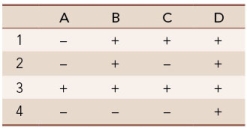Wild-type bacteria can synthesize substance D, but various mutant strains cannot.We know that substance D is synthesized from substance X in a pathway that involves three intermediate substances (A, B, and C) , but we do not know the order of the steps in the pathway.The table shows four different mutant strains that have been tested for their ability to grow on the various substances.A "+" means that the strain can grow on that substance; a "-" means that the strain cannot grow on that substance.  Based on these data, what is the most likely order of the pathway? (A, B, C, D means that substance A is converted to substance B, which is converted to substance C, which is converted to substance D.)
Based on these data, what is the most likely order of the pathway? (A, B, C, D means that substance A is converted to substance B, which is converted to substance C, which is converted to substance D.)
Definitions:
Dendrites
Branch-like extensions of neurons that receive signals from other nerve cells and are integral for brain communication.
Neurotransmitters
Chemical substances in the nervous system that transmit signals across a synapse from one neuron to another, influencing mental states and behavior.
Alleles
Variants of a gene that occur at the same place on a chromosome, contributing to the diversity of traits in a population.
Dominant
Pertaining to a trait, allele, or characteristic that overrides or masks another in genetic expression.
Q44: Two genes with two alleles each are
Q72: How is it possible for single-stranded RNA
Q87: The short "starter" strand used in DNA
Q122: In complementary base pairing, G will pair
Q132: <font face="symbol"></font>-galactoside transacetylase is<br>A) a promoter.<br>B) encoded
Q136: If the gene encoding the trp repressor
Q217: What fraction of offspring of the cross
Q223: Errors in transcription occur about 100,000 times
Q233: Gel electrophoresis<br>A) causes DNA fragments to be
Q252: In skin fibroblasts heavily exposed to sunlight,